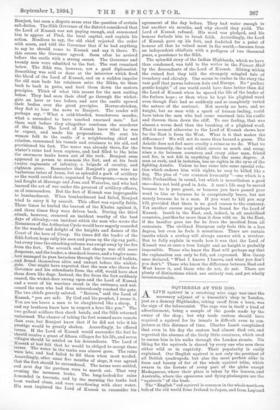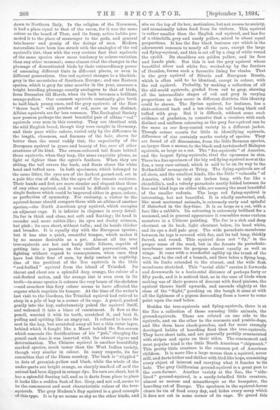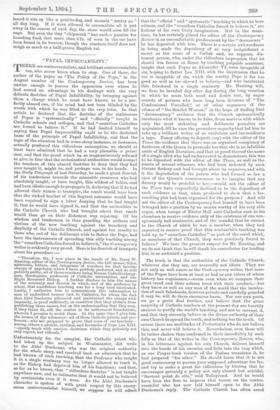A LIVE squirrel in a revolving wire cage was once
the necessary adjunct of a tinsmith's shop in London, Kussak, " you are safe. By God and his prophet, I swear it. just as a dummy Highlander, taking snuff from a horn, was You are too brave a man to be slaughtered like a sheep. I the sign of the tobacconist. The cage was in itself a kind of advertisement, being a sample of the goods made by the owner of the shop ; but why trade custom should have t required a squirrel for its inmate is difficult even to con- than ever, but Runjeet knew that if he did not take it his that the fort should be surrendered. s siege' it was agreed all British quadrupeds, but also the most perfect alike in The terms were settled, and next day the garrison were to march out. That very form and beauty of fur of the whole squirrel tribe, which swarm in the forests of every part of the globe except evening the monsoon broke. the long-looked-for rains Madagascar, where their place is taken by the lemurs, and descended in torrents, and by Australia, where the opossums and flying-pbalangers are the been washed clean, and were overflowing with clear water. The " English " red squirrel is common in the whole northern His men implored the Lord of Kussak to reconsider his belt of the old world from Ireland to Japan, and from Lapland down to Northern Italy. In the religion of the Norsemen, it had a place equal to that of the raven, for it was the same colour as the beard of Thor, and its fussy, active habits pro- moted it to the place of messenger to the gods, and general tale-bearer and gossip of the doings of men. Modern naturalists have been less struck with the analogies of the red squirrel's tint, than with the very curious fact that squirrels of the same species show more tendency to colour-variation than any other mammal; some almost rival the changes in the plumage of domesticated birds by their extraordinary power of assuming different tints in different places, or even in different generations. Our red squirrel changes to a blackish- grey in the mountains of Southern Europe; and one Eastern species, which is grey for nine months in the year, assumes a bright breeding plumage exactly analagous to that of birds, from December till March, when its back becomes a brilliant orange-yellow. Our common squirrels constantly give birth to half-black young ones, and the grey squirrels of the East "throw back" with patches of red, more or less distinct. Albino squirrels are far less common. The Zoological Society now possess perhaps the most beautiful pair of albino " red" squirrels ever seen in this country. They are identical with the wild English breed, though they were caught in Germany, and their pure white colour, varied only by the difference in the length, closeness, and fineness of the hair, shows far better than the usual ruddy tint, the superiority of the European squirrel in grace and beauty of far, over all other creatures of its kind. The cream-coloured tail floats behind these squirrels, when they leap, like some exquisite plume, as light or lighter than the egret's feathers. When they are sitting, the tail covers the back, and floats above the white head and tufted ears. In both specimens, which belonged to the same litter, the eyes are of the darkest garnet-red, set in a pale blue rim of skin, like the eyes of the roseate cockatoo. Their hands and feet are more slender and elegant than those of any other squirrel, and it would be difficult to suggest a single feature which could be improved either in grace, colour, or perfection of symmetry. For curiosity, a visitor to the squirrel-house should compare these with an albino of another species,—the North American grey squirrel, which occupies an adjacent cage. It is inferior in elegance in every detail. Its fur is thick and close, not soft and floating; its head is rounder and more rabbit-like; its eyes not dusky crimson, but pink ; its ears short, without tufts ; and its hands thicker and broader. It is equally shy with the European species ; but it has also a quick, resentful temper, which makes it by no means desirable as a pet. Almost all the true tree-squirrels are hot and hasty little fellows, capable of getting into a passion on the smallest provocation, and fighting without regard to consequences, when once they have lost their fear of man, by daily contact in captivity. One of the prettiest of the Zoo squirrels is the little " red-bellied " squirrel from the island of Trinidad. Its throat and chest are a splendid deep orange, the colour of a red-fleshed melon, and the orange tint is seen even in its teeth—in some species it colours the very bones of the skeleton —and somehow this fiery colour seems to have affected the organs which regulate its temper. At the time of the writer's last visit to the Gardens, the Trinidad squirrel had retired to sleep in a pile of hay in a corner of its cage. A pencil, pushed gently into the hay, unfortunately poked the squirrel itself, and wakened it into a blaze of resentment. It flew at the penoil, worried it with its teeth, scratched it, and beat it, puffing and spitting like an angry oat. It refused to leave its nest in the hay, but scratched away all but a thin outer layer, behind which it fought like a Maori behind the flax-screen which conceals the fortifications of his " pah," charging the pencil each time it was inserted with the utmost vigour and determination. The Chinese squirrel is another beautifully marked species, much tamer than the West Indian variety, though very similar in colour. In many respects, its fur resembles that of the Diana monkey. The back is " stippled " in dots of greenish-yellow and black, while the whole of the under-parts are bright orange, as sharply marked off as if the animal had been dipped in orange dye. Its ears are short, but it has a splendid floating tail, and as it darts from place to place it looks like a sudden flash of fire. Grey, and not red, seems to be the commonest and most characteristic colour of the tree- squirrels. The grey Hudson's Bay squirrel is a good example of this type. It is by no means so shy as the other kinds, and sits on the top of its box, motionless, but not averse to society, and occasionally takes food from its visitors. This squirrel is rather smaller than the English red squirrel, and has fur of a chinchilla grey and sandy yellow, mixed in about equal proportions. It has the fine black lustrous eye which is the adornment common to nearly all the race, except the large red flying-squirrel, and this is set off by a ring of white round the eyelid. Its shoulders are golden yellow, and its face and hands pink. But this is not the grey squirrel whose beautiful silver and white fur, worked-up by the furriers of Dresden, forms such a favourite lining for cloaks. That is the grey squirrel of Siberia and European Russia, which is often said to be identical, except in colour, with the red squirrel. Probably, by making a collection of all the old-world squirrels, graded from red to grey, showing all the intermediate stages of red and grey in varying proportions as they occur in different districts, this identity could be shown. The Syrian squirrel, for instance, has a slate-coloured back and a tan chest, its tail being black and tufted with grey. But it is difficult, without some such evidence of gradation, to conceive that a creature with such distinct and uniform colouring as the grey fur-squirrel can be the same as our fiery-coated variety in a different jacket. Though colour counts for little in identifying squirrels, difference of size certainly marks variety of species. They are found of all dimensions, from the little Bornean species, no larger than a mouse, to the black-and-tortoiseshell Malayan squirrels, as large as a cat. The " fox-squirrels " of America, and the largest flying-squirrels, rival the opossums in size. There is a fine specimen of the big red flying-squirrel now at the Zoo, a very rare animal, which is said to be on its way to the Rothschilds' menagerie at Tring. The flying-squirrels are of all sizes, and the smallest kinds, like the little " volucella " of America, which is only six inches long, with fur like a chinchilla's, and a velvety parachute neatly folded between its fore and hind legs on either side, are among the most beautiful of the smaller rodents. The large red flying-squirrel is interesting, but not beautiful. It is wholly nocturnal, and, like most nocturnal animals, is extremely surly and spiteful if disturbed in the daytime. It is as large as a cat, with a face like a rabbit's. Its colouring is extremely brilliant for a mammal, and in general appearance it resembles some curious monsters in a Chinese painting. The fur is a rich and deep chestnut on its back, light chestnut below, its head white, and its eye a dull pale grey. The wide parachute-membrane between its legs is covered with fur, and its tail long, thickly furred, and round. This squirrel does not " fly," in the proper sense of the word, but in the forests its parachute- membrane answers its purpose almost equally as well as wings. It runs with a wonderful agility up the trunk of the tree, and to the end of a branch, and then takes a flying leap, with its limbs extended to the utmost, and the wide flesh membrane stretched. This "aerial slide" carries it forwards and downwards to a horizontal distance of perhaps forty or fifty yards, and it is noticed that, as in the case of birds when making use of their powers of descent with fixed pinions, the squirrel throws itself upwards, and ascends slightly at the close of the "flight," perching on the bough it aims at with all the lightness of a pigeon descending from a tower to some point upon the roof below.
Besides the tree-squirrels and flying-squirrels, there is at the Zoo a collection of those amusing little animals, the ground-squirrels. These are related on one side to the squirrels, and on the other to the marmots and prairie-dogs, and like them have cheek-pouches, and far more strongly developed habits of hoarding food than the tree-squirrels. They have short tails, and are generally prettily ornamented with stripes and spots on their sides. The commonest and most popular kind is the little North American " chipmunk." This pretty little creature is the common pet of American children. It is more like a large mouse than a squirrel, never still, and darts hither and thither with bird-like hops, examining every object of interest and carrying what it fancies to its hole. The grey Californian ground-squirrel is a great pest to the corn-farmer. Another variety at the Zoo, the " side- lined" ground-squirrel, is a sandy-brindled little creature, almost as morose and misanthropic as the hampster, the hoarding rat of Europe. The specimen in the squirrel-house clears its tin of food every day, and hides every scrap which it does not eat in some corner of its cage. To guard this hoard it sits up like a prairie-dog, and mounts " sentry go " all day long. If it were allowed to accumulate all it put away in the course of each day, the store would soon fill the cage. But even the tiny " chipmunk " has such a passion for hoarding food, that more than 8 lb. of corn in the ear have been found in its burrow, though the creature itself does not weigh so much as a half-grown English rat.




































 Previous page
Previous page